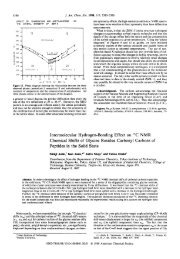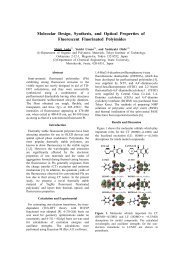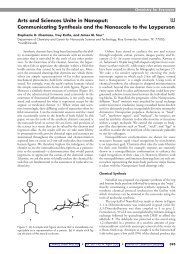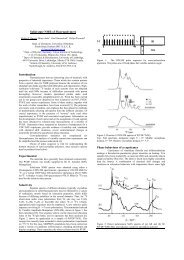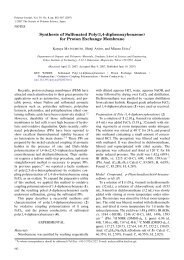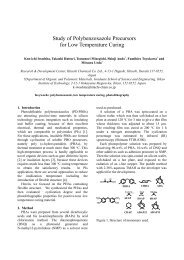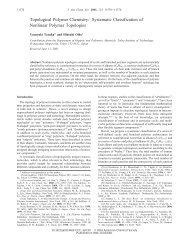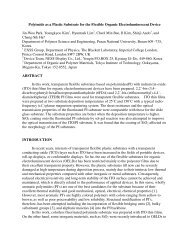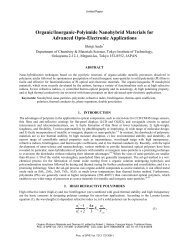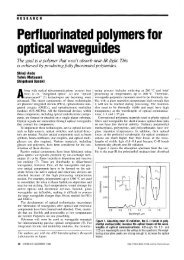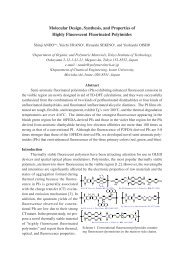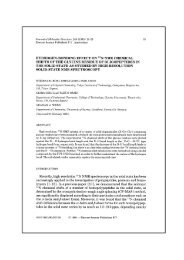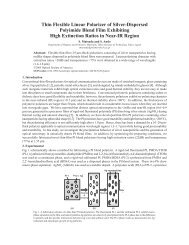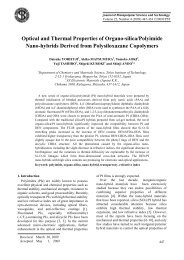Optical Properties of Fluorinated Polyimides and Their Applications ...
Optical Properties of Fluorinated Polyimides and Their Applications ...
Optical Properties of Fluorinated Polyimides and Their Applications ...
Create successful ePaper yourself
Turn your PDF publications into a flip-book with our unique Google optimized e-Paper software.
(dn/dT) <strong>of</strong> refractive indices <strong>of</strong> polymeric materialsincluding PIs is much larger than silica, thermo-optic(TO) switch can be a good target <strong>of</strong> polymerwaveguide circuits. Kobayashi et al. [71] installed ametal heater on the both sides <strong>of</strong> a Y-branchedwaveguide fabricated using copolymers <strong>of</strong> 3 <strong>and</strong> 5,<strong>and</strong> examined its digital TO switching performance.By using a FPI exhibiting a large TO coefficient, therequired electric power for switching can be effectivelyreduced. Moreover, Ido et al. [72] produced a1x8 digital TO switch by combining three steps <strong>of</strong>1x2 TO switches fabricated by FPIs. On the otherh<strong>and</strong>, Fujita et al. [73] produced a 2x2 TO switchusing FPIs by combining a TO switch <strong>and</strong> an opticalattenuator. This circuit can be useful as an add-dropcircuit in the WDM systems.3.6.4 Polarization SplittersAs stated in Section 2.3, aromatic PIs having rigidmolecular structures exhibit large birefringence comparedwith quartz or other organic polymers. Usingthis character, Oh et al. [74] fabricated a Y-branchoptical waveguides by combining waveguides <strong>of</strong> nonbirefringentpolymeric materials (polyetherketone,perfluorocyclobutane) <strong>and</strong> highly birefringent FPIs.For a branch circuit <strong>of</strong> one side including PIwaveguide (TE-branch), the light propagating conditionis attained only for the TE mode. Hence, thiscircuit functions as a polarization splitter which dividesthe incidence light into the TE polarization <strong>and</strong>the TM polarization. The insertion loss <strong>of</strong> this splitterincluding the connection loss between thewaveguides <strong>and</strong> the input / output-fibers was 3.8 dBat 1.55 µm, <strong>and</strong> the cross talk was below −20 dB.3.6.5 <strong>Optical</strong> Networking Unit (ONU)With the progress <strong>of</strong> optical-communication technology<strong>and</strong> the Internet technology, the Fiber To TheHome (FTTH) projects was started in the last decade.This project aims to introduce optical-fiber networksto every places <strong>of</strong> working <strong>of</strong>fices <strong>and</strong> homes in Japan.An opto-electronic mixed-loading components(<strong>Optical</strong> Networking Unit, ONU, Fig. 15), which performtransmission <strong>and</strong> detection <strong>of</strong> optical signals <strong>and</strong>inter-conversion <strong>of</strong> optical <strong>and</strong> electric signals, areindispensable at all subscribers in the FTTH system.Ido et al. [72, 75] produced optical transceiver modulesusing FPI waveguides at a low cost, <strong>and</strong> reportedthat good fundamental properties (optical output >2mW @ 60mA, detection sensitivity >0.39 A/W) wereobtained. Moreover, since the refractive index <strong>of</strong> thecladding <strong>of</strong> FPI is higher than that <strong>of</strong> silica, manyadvantages are given. For example, the cladding layer<strong>of</strong> FPI can be thin because the waveguides are fabricatedon Si substrate covered by SiO 2 thin layer, <strong>and</strong>the alignment between the core <strong>of</strong> waveguide <strong>and</strong> thesemiconductor optical elements (LD, PD) in the verticaldirection becomes easy.4. Summary <strong>and</strong> Future ProspectsIn this article, the outline <strong>and</strong> circumstances onthe basic optical properties <strong>and</strong> the applications <strong>of</strong>FPI optical materials are widely reviewed, in particularfor aiming at the application to optical components,opto-electronic devices, <strong>and</strong> optical interconnection.The optical transparency in the visible <strong>and</strong>NIR regions was greatly improved by partial fluorination<strong>of</strong> polyimides, but much further progress inthe optical transparency at the optical-communicationswavelengths was attained by the development<strong>of</strong> perfluorinated polyimides. The controls in refractiveindices, birefringence, <strong>and</strong> thermo-optic coefficientswere also attained by the progress in advancedmolecular design, copolymerization, <strong>and</strong> uniaxialdrawing technology. Moreover, the progress in thefine-patterning <strong>and</strong> processing technology using variousmethods supports the fine processing <strong>of</strong> opticalwaveguides with high precision. Many optical components<strong>and</strong> optical devices have been already developed,<strong>and</strong> optical applications <strong>of</strong> FPIs on the basis <strong>of</strong>such components are coming to extensive use in nearfuture. Although further examinations are requiredfor the reliability <strong>and</strong> the optical mounting technology,FPI optical material is promising due to its veryattractive characteristics. More active researches areexpected to be continued for further progress.AckowledgementsThe author thanks Dr. F. Yamamoto, Dr. S. Sasaki,Dr. T. Matsuura, Dr. Y. Inoue, Mr. T. Sawada, Mr. S.Matsuda, <strong>and</strong> Mr. Y. Terui for their helpful discusssions<strong>and</strong> fruiteful collaborations.References1) Y Imai, R. Yokota, Eds. “Novel Polyimide - Basics<strong>and</strong> <strong>Applications</strong>”, (Japanese) Japan PolyimideConference, NTS, p.601 (2002).a) S. Ando, “Chemical Structures <strong>and</strong> <strong>Optical</strong> <strong>Properties</strong><strong>of</strong> <strong>Polyimides</strong>” (Basics Part, Chap.5),b) S. Ando, T. Matsuuta, “<strong>Fluorinated</strong> <strong>Polyimides</strong>”(Application Part, Chap.4).2) Y. Imai, M. Kakimoto, R. Yokota, Eds. “The LatestProgress in <strong>Polyimides</strong>, Annual Reports <strong>of</strong> JapanPolyimide Conference”, (Japanese) Japan PolyimideConference, Vol.1 (1993)〜 Vol.12 (2004).3) K. Ihara, S. Kojiya “Fluoropolymers”, (Japanese)Polymeric New Materials Series-23, KyoritsuPublisher (1990).230



